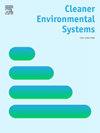LCA of precious metals recovery: Modelling the secondary supply of gold, silver, platinum, palladium and rhodium from an integrated refining plant
IF 4.9
Q2 ENGINEERING, ENVIRONMENTAL
引用次数: 0
Abstract
Precious metals are essential elements in modern technology and the green transition, with limited alternatives on the market. Primary production is the main supply source to meet their current demand, with secondary sourcing remaining still quite limited. Indeed, although precious metals could last virtually forever in the anthroposphere, and thus be potentially available for recycling, their value chain is characterized by inefficiencies and material losses that prevent the closure of material flows. In addition to the challenge of improving recovery and recycling processes, there is also the need to quantify the environmental impact associated with secondary sources to support informed choices.
In this work, we apply life cycle assessment (LCA) to estimate the potential environmental impacts associated with an integrated refining process for precious metals (i.e., gold, silver, platinum, palladium, and rhodium), recovered from heterogeneous waste inflows including production scrap, spent catalysts, liquid waste, and incineration ash. The LCA model was created by mainly using primary data collected from the integrated refining plant, located in northern Italy, complemented with secondary data from the relevant literature. The ReCiPe 2016, IPCC 2021 GWP100, and CED methods were used for life cycle impact assessment. The resulting carbon footprint amounted to 0.43 t CO2 eq/kg Au, 0.01 t CO2 eq/kg Ag, 0.47 t CO2 eq/kg Pd, 0.18 t CO2 eq/kg Pt, 1.55 t CO2 eq/kg Rh, respectively. The insights complement the existing datasets for LCA and are expected to inform stakeholders engaged with the sustainability challenge in the life cycle of precious metals.
贵金属回收的生命周期分析:模拟一个综合精炼厂的金、银、铂、钯和铑的二次供应
贵金属是现代技术和绿色转型的重要元素,市场上的替代品有限。初级生产是满足其当前需求的主要供应来源,二级来源仍然相当有限。事实上,虽然贵金属几乎可以在人类圈中永远存在,因此有可能被回收利用,但它们的价值链的特点是效率低下和材料损失,阻碍了物质流动的关闭。除了改进回收和再循环过程的挑战外,还需要量化与二手来源有关的环境影响,以支持知情选择。在这项工作中,我们应用生命周期评估(LCA)来评估与贵金属(即金、银、铂、钯和铑)的综合精炼过程相关的潜在环境影响,这些贵金属是从包括生产废料、废催化剂、废液和焚烧灰在内的异质废物流入中回收的。LCA模型的创建主要使用了从位于意大利北部的综合炼油厂收集的原始数据,并辅以相关文献中的次要数据。使用ReCiPe 2016、IPCC 2021 GWP100和CED方法进行生命周期影响评估。所得碳足迹分别为0.43 t CO2当量/kg Au、0.01 t CO2当量/kg Ag、0.47 t CO2当量/kg Pd、0.18 t CO2当量/kg Pt、1.55 t CO2当量/kg Rh。这些见解补充了LCA的现有数据集,预计将为参与贵金属生命周期可持续性挑战的利益相关者提供信息。
本文章由计算机程序翻译,如有差异,请以英文原文为准。
求助全文
约1分钟内获得全文
求助全文
来源期刊

Cleaner Environmental Systems
Environmental Science-Environmental Science (miscellaneous)
CiteScore
7.80
自引率
0.00%
发文量
32
审稿时长
52 days
 求助内容:
求助内容: 应助结果提醒方式:
应助结果提醒方式:


